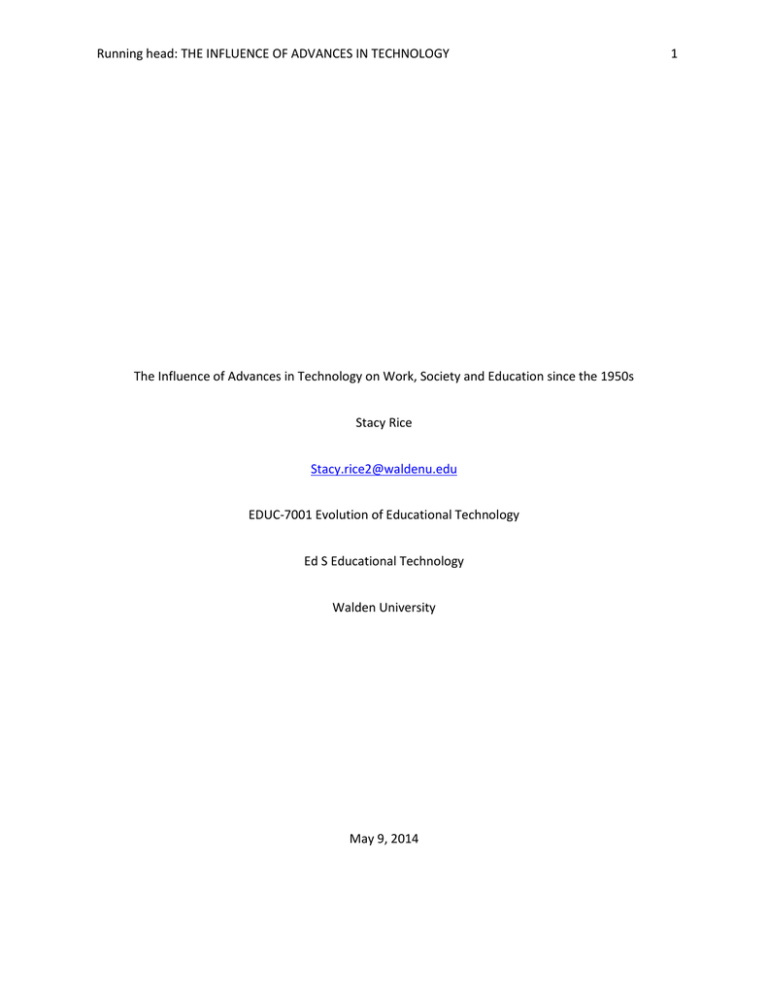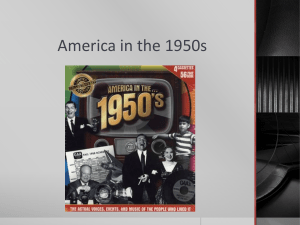Running head: The Influence of Advances in Technology The
advertisement

Running head: THE INFLUENCE OF ADVANCES IN TECHNOLOGY The Influence of Advances in Technology on Work, Society and Education since the 1950s Stacy Rice Stacy.rice2@waldenu.edu EDUC-7001 Evolution of Educational Technology Ed S Educational Technology Walden University May 9, 2014 1 Running head: THE INFLUENCE OF ADVANCES IN TECHNOLOGY 2 After reading A third Wave by Alvin Toffler and completing a timeline that identifies historical events since 1900 to now, I have chosen to focus my analysis on the 1950s, 1980s, and 2000s. These particular decades were chosen because I think they best represent the beginnings of the information wave as well as the emergence of a fourth wave. Each decade includes key historical events that occurred that influenced the development of new technologies, the way we worked, our economy, our social interactions and how we approached education. With the emergence of the computer and increase in science and technical advances the 1950s ushered in a new era that began to shift work life from the factories and into “the office”. The change in technology also changed our focus from nonrenewable energies, which were the focus of the industrial age to finding cheaper, renewable sources for energy. As we enter into what can be considered a fourth wave, we once again see a change in the way we view work – no longer is it necessary to travel to an office to work or even further one’s education or training. We interact differently, with each other and our environment, because of advances in technology. Even Toffler had predicted that the information wave may only take a few decades before another wave emerges (Toffler, 1980). The 1950s saw the emergence of a new wave, the information wave. During the 1950s we begin to see the first of many technological advances that influenced the technology we use today. The UNIVAC 1 emerged becoming the first commercial computer to gain wide-spread public attention. It was first sold to the United States Census Bureau in order to help them collect and calculate census data (U.S. Deptartment of Commerce, 2014). This decade also saw the first microchip (monolithic integrated circuit), invented by Jack Kilby, an employee of Texas Instruments, in 1958 (Texas Instruments, 2014). While its first real use was within the United States Air Force it would later find a place in the general market with the introduction of the calculator (Texas Instruments, 2014). One cannot discuss the fifties without mentioning the Cold War and its effects on technology and society. The cold war brought about a race to invent highly destructive weapons which led to the invention of the hydrogen bomb. While a deadly weapon had been invented capable of leveling cities, it uncovered the possibility for less expensive energy. This gave rise to the nuclear power plant, the first built in 1954 (Shmoop Editorial Team, 2014). While we were not at war, we were fearful of nuclear attacks and communist take overs. Technological advances became a race between powerful countries. When Russia successfully launched the first satellite into orbit it increased paranoia and anxiety in the U.S. over issues of espionage and increased the push technological advances to compete with Russia, leading to the creation of NASA (Shmoop Editorial Team, 2014). Society made a shift during the fifties as well. More and more people moved toward the cities into the suburbs and out of the rural agricultural areas. Unemployment was low, television became a common item in households, and the automotive industry once again saw a boom in production as more and more families owned cars. We also saw the first Interstate highway system, which not only created jobs but made a significant impact on cross-country travel (Shmoop Editorial Team, 2014). After suffering through the great Depression, the society of the fifties was focused on satisfying wants and desires rather than basic needs, leading to an entirely different way of life and standard of living than had been previously experienced. We had become a nation of consumers and a society beginning to experiment with debt with the emergence of the credit card. Running head: THE INFLUENCE OF ADVANCES IN TECHNOLOGY 3 Education was also impacted by the events of the fifties. Integration within schools begins to take place with Brown vs. the Board of Education. It was in 1958 that Congress passed the National Defense of Education Act to ensure the United States had the best highly trained individuals in the science and technology fields. The NDEA was created in response to the launch of Sputnik and the continued competition between the U.S. and the Soviet Union (U.S. Department of Education, 2012). In the eighties we are fully enveloped in the information wave. The personal computer, first introduced by IBM makes its debut 1981. It popularity leads it to be named Time Magazines “Person of the Year” in 1983 (Computer History Museum, 2004). Apple introduces the Macintosh computer in 1984. The first version of the Windows operating system is released in late 1985. The eighties bring the creation of Supercomputer Centers and the first commercialization of the internet (Computer History Museum, 2004). We were still in the Cold War with the Soviet Union and once again technology advances were also centered on military defense. In 1983, the Star Wars program is proposed to develop technology that will intercept incoming missiles (America's Best History, 2014). Space exploration is also a key as we have the first space shuttle launch and first woman in space to follow all taking place during the eighties. Unfortunately, the economy does not fare well early in the decade with soldiers returning from the Vietnam War unable to find jobs sending unemployment into record numbers not seen since the times of the Great Depression. The country also finds itself competing with foreign goods that cut into the profits of U.S. corporations (Shmoop Editorial Team, 2014). In an effort to stimulate the economy, which had entered into a recession, Congress passed a tax bill proposed by Ronald Reagan that cut income taxes by 25% (Shmoop Editorial Team, 2014). The general feeling during this period is that the government was the problem and during Reagan’s leadership there is a trend toward free market and less government regulation. This had mixed results resulting in an initial boom in the stock market leading to a major crash in 1987. In 1989, there was a need for legislation to provide tax payer bailouts to the savings and loan industry (Shmoop Editorial Team, 2014). Education underwent reform during the eighties as well when the report “A Nation at Risk” took a critical look at the quality of public education. ” A Nation at Risk provided a much-needed national jolt, shaking Americans out of their complacency and indifference to the state of the schools. What sunk in-to business leaders, editorial writers, and civic agencies--was that America could not prosper unless its schools were successful” (Ravitch, 1990). Reforms in teacher education programs began which led to the creation of the National Board for Professional Teaching Standards in order to develop national certification exams. The curriculum was also a target of reform beginning the debate over frameworks and assessments (Ravitch, 1990). I believe the only problem and what might have actually caused the attention being drawn to education is that it is an area that was still largely working with industrialized ideas where students are taught in an assembly line style, and society and technology are shifting toward the ideology of the information age which values specialization and individualization (Toffler, 1980). As we enter the year 2000, we have already begun what can be considered a fourth wave. This is a wave of communication and the technologies that are being developed are shifting once again Running head: THE INFLUENCE OF ADVANCES IN TECHNOLOGY 4 toward this idea of connectedness and communication. The internet has exploded and has evolved from its early years as a repository of information to a fluid and constantly changing space where anyone can be an author of the content such examples include the creation Facebook in 2004 or YouTube in 2005 (America's Best History, 2014). Our technology became more portable during this decade with the creation of the iPod in 2001, the iPhone in 2007, and the iPad in 2010 allowing us to access the internet almost anywhere (America's Best History, 2014). Websites like Wikipedia formed where anyone could collaborate on the authoring of information has led to history being recorded almost as it happens. We still value individuality but diversity is a key theme in this decade and not just diversity in regards to culture, but also in our family structure, our workplace and the vast number of religions. It is this decade in which we see our first African-American President as Barack Obama is elected to office in 2008 (America's Best History, 2014). This decade also brings a less formal working environment, offices of the previous decade where lined with men and women dressed in business attire, now we have CEOs wearing jeans and t-shirts and being known not as “Mr. Jobs” but as simply “Steve” (Crouch, 2011). A growing concern with the environment and the fear of the depletion of fossil fuels leads to production and focusing on renewable sources of energy like the hybrid automobile and wind and solar energy sources. This decade also saw another war as the United States faced a terrorist attack in 2001, leading to the Iraq war. The economy begins to decline and the U.S. enters another recession preceded by the housing bubble burst in 2008 causing a rise in unemployment in areas related to construction and real estate (U.S. Department of Labor, 2011). It brought with a $700 billion financial bailout for corporations like Citigroup, Bank of America, and GMAC. Education was also influenced by the changes in technology during this decade as the skills needed to survive in this new wave are skills that include technology as well as the ability to think critically and work collaboratively. Technology development in the 2000s has given students increased access to information, media, and variety as to where they acquire their education. Online learning has opened the door to a choice in where students learn as well as flexibility in the learning schedule. Social media has even had an influence on education allowing students and teachers to stay connected and collaborate outside of the confines of the classroom walls. There are challenges, of course, to this change such as teacher training to utilize the technology as well as schools having financial resources and infrastructure to support the advanced technologies (Education Week, 2011). The advances in technology over these three decades have had a great impact on society, employment, culture and education. As technology has advanced it has changed the way we interact with each other and our environment. It also changes what we value within our professional and personal lives. Those that are resistant to change seem to struggle the most but the advances and changes will continue. It is this resistance that often causes the conflict within society because it is a clash of ideology and values, as technology evolves so does the human race. Running head: THE INFLUENCE OF ADVANCES IN TECHNOLOGY References America's Best History. (2014). The 1980's - The Reagan Revolution. Retrieved from Americasbesthistory.com: http://americasbesthistory.com/abhtimeline1980.html America's Best History. (2014). U.S. Timeline. Retrieved from Americasbesthistory.com: http://americasbesthistory.com/abhtimeline2000.html Computer History Museum. (2004). Exhibits: 1980. Retrieved from Computer History Museum Website: http://www.computerhistory.org/internet_history/internet_history_80s.html Crouch, A. (2011). Ten most significan cultural trends of the last decade. Retrieved from Q: http://qideas.org/articles/ten-most-significant-cultural-trends-of-the-last-decade/ Education Week. (2011). Technology in Education. Retrieved from Educationweek.org: http://www.edweek.org/ew/issues/technology-in-education/ Ravitch, D. (1990, 01 10). Education in the 1980's: A Concern for 'Quality'. Retrieved from Education Week: http://www.edweek.org/ew/articles/1990/01/10/09200009.h09.html Shmoop Editorial Team. (2014). "The 1950s" . Retrieved from Shmoop.com: http://www.shmoop.com/1950s/science-technology.html Texas Instruments. (2014). The Chip that Jack Built. Retrieved from Texas Instruments: http://www.ti.com/corp/docs/kilbyctr/jackbuilt.shtml Toffler, A. (1980). The third wave. New York: Bantam Books. U.S. Department of Education. (2012, 02 13). Overview: the federal role in education. Retrieved from ED.gov: http://www2.ed.gov/about/overview/fed/role.html?src=ln 5 Running head: THE INFLUENCE OF ADVANCES IN TECHNOLOGY U.S. Deptartment of Commerce. (2014, March 31). UNIVAC I. Retrieved from United States Census Bureau: https://www.census.gov/history/www/innovations/technology/univac_i.html 6








